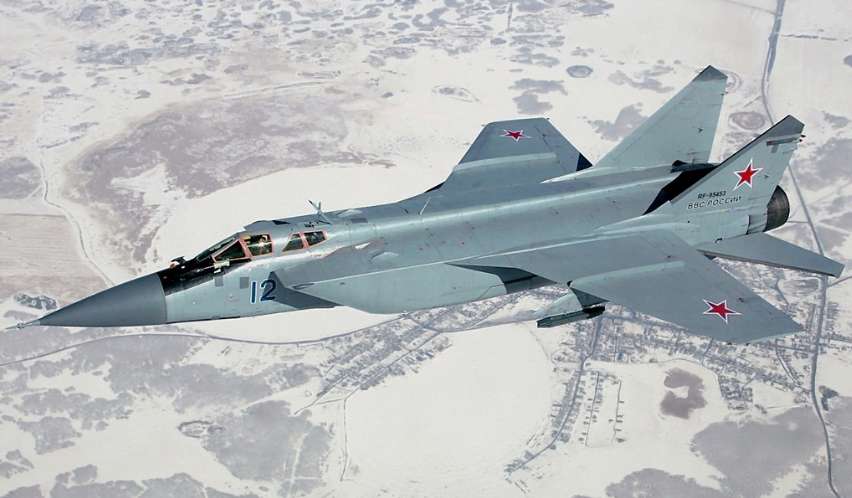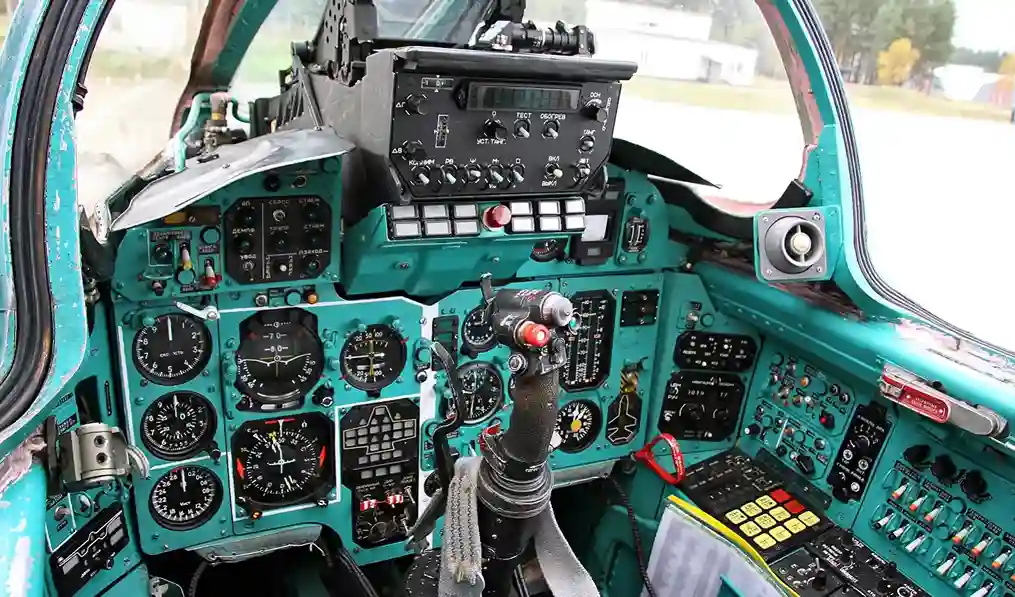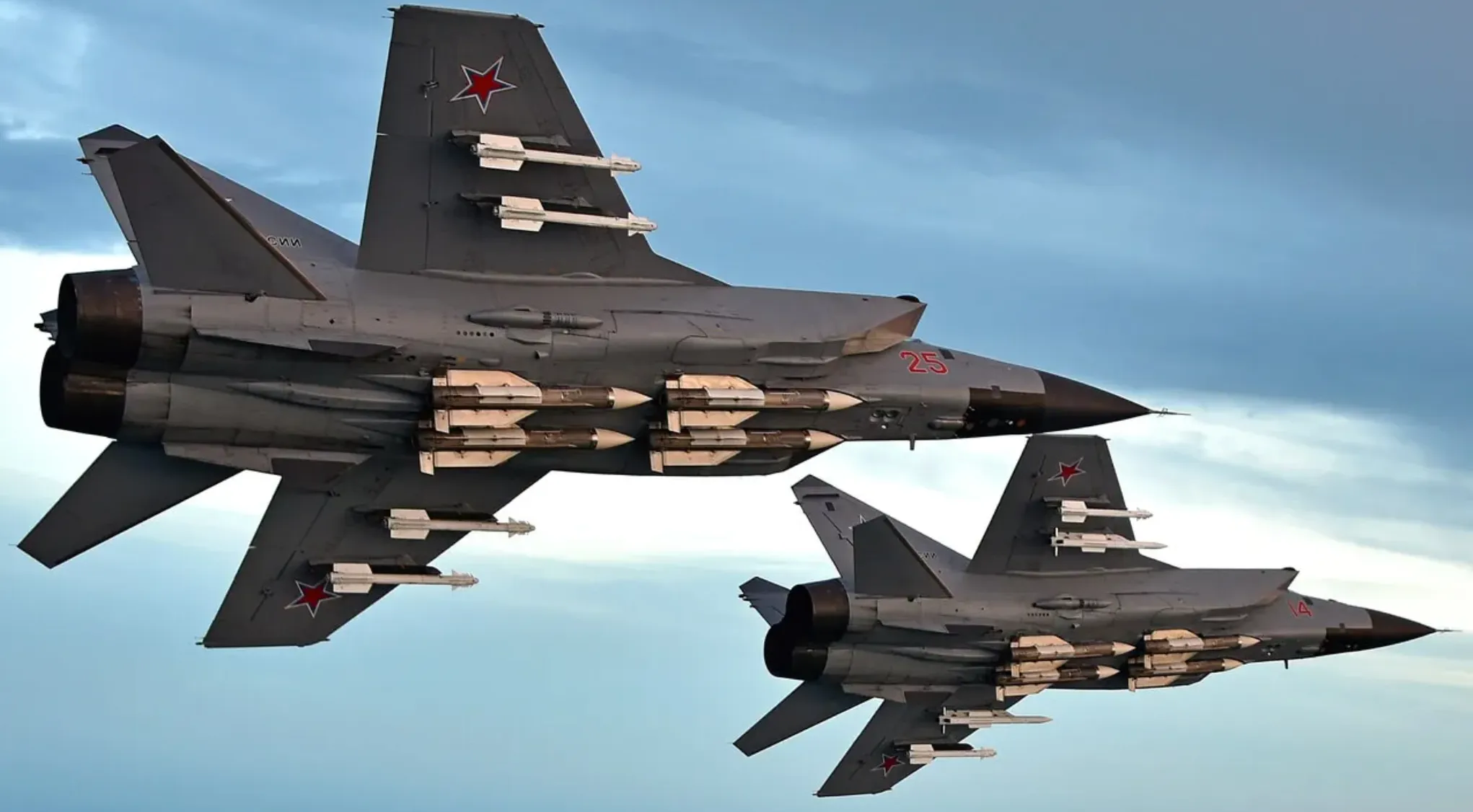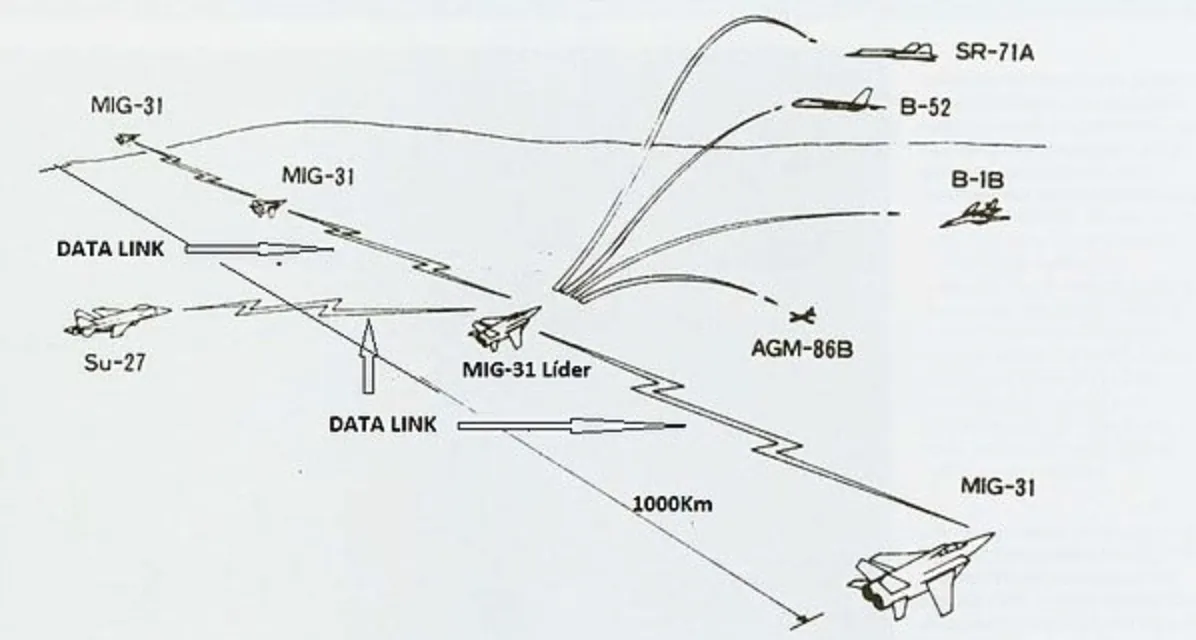Follow Us:
Share
Table of Contents:
The Mikoyan MiG-31 Foxhound is a high-speed, supersonic interceptor aircraft designed by the Mikoyan design bureau for the Soviet Air Forces. It was developed as a successor to the earlier MiG-25 “Foxbat,” and while it incorporates some design features from the MiG-25, it also boasts significant advancements.
The MiG-31 is recognized as one of the fastest operational combat aircraft in the world, capable of reaching speeds of approximately 3,000 kilometers per hour (about 1,900 miles per hour) as of 2021.
Following the dissolution of the Soviet Union in 1991, the Mikoyan MiG-31 Foxhound continued to be actively used by the Russian Aerospace Forces. While Kazakhstan also operated the aircraft through its Air Defense Forces, they officially retired the MiG-31 fleet in 2023.
However, Russia plans to keep the MiG-31 in service until at least 2030. In 2020, the Russian Ministry of Defense confirmed a service life extension for the MiG-31, increasing the airframe’s operational limit from 2,500 hours to 3,500 hours.
MiG-31 Foxhound Production
The MiG-25 Foxbat, while known for its high-speed performance, had significant limitations, particularly in its inability to operate effectively at low altitudes.
The aircraft’s inefficient turbojet engines caused a reduction in combat range when flying at supersonic speeds and pushing the speed too far risked damaging the engines, often leading to catastrophic failure.

To address these shortcomings, the Mikoyan MiG-31 Foxhound was developed as an advanced successor. It was specifically designed to maintain supersonic speeds at low altitudes, a critical improvement over the MiG-25.
The MiG-31 features more efficient low-bypass-ratio turbofan engines, which not only improve overall performance but also extend the aircraft’s combat range.
Production of the Mikoyan MiG-31 Foxhound began in 1979, and by 1982, it had fully entered service with the Soviet Anti-Air Defense Forces (PVO).
However, during the economic downturn in the USSR, the high cost of maintaining these complex aircraft led to about 20% of the fleet being grounded.
Despite this, approximately 75% of the MiG-31 aircraft were brought back into service with the Russian Air Force in 2006, thanks to the country’s renewed economic strength.
MiG-31 Upgrades and Replacement
Several upgrade programs have been introduced to enhance the capabilities of the MiG-31 fleet, with one of the most notable being the MiG-31BM multirole variant.
This upgraded version features modern avionics, a new multimode radar, and advanced cockpit controls, including hands-on-throttle-and-stick (HOTAS) systems and color liquid crystal multi-function displays (LCD MFDs).
Additionally, the MiG-31BM has been equipped to carry advanced weaponry, such as the R-77 missile and various Russian air-to-ground missiles (AGMs), including the Kh-31 anti-radiation missile. The upgrade also includes a more powerful onboard computer and digital data links.
The project to modernize the Russian MiG-31 fleet to the MiG-31BM standard began in 2010, with the goal of upgrading 100 aircraft by 2020.
According to Colonel Yuri Balyko from the Russian Ministry of Defense, this upgrade significantly boosts the combat effectiveness of the aircraft, enhancing its performance multiple times over.
In 2014, 18 MiG-31BM aircraft were delivered to the Russian military. By April 2015, Russian Deputy Defense Minister Yuri Borisov confirmed that more than 130 upgraded MiG-31BM units were expected to be delivered, with 24 aircraft already received by that time.
MiG-31 Design
The Mikoyan MiG-31 Foxhound is engineered with a sleek, aerodynamic body that allows it to maintain high speeds, even when flying at low altitudes. One of its standout features is its ability to track multiple targets at once, particularly in high-altitude environments, making it a highly effective interceptor.

The aircraft’s airframe is built from a variety of materials, including 49% welded nickel steel, 16% titanium, 33% aluminum alloy, and 2% composite materials. The MiG-31 also features four underwing pylons integrated into the fuselage for additional payload capabilities.
In terms of design, the fuselage incorporates lateral rectangular and diagonal-cut air intakes, which are essential for efficient airflow at high speeds. It also has a bubble-shaped canopy for enhanced visibility, along with a long, pointed nose.
The wings are sharply swept back with square tips and a negative slant, further improving its aerodynamic performance and stability during supersonic flight.
MiG-31 Foxhound Variants
The MiG-31 Foxhound has been developed in a variety of versions, each with its unique capabilities and features. The primary variants include the MiG-31A, MiG-31B, MiG-31BS, MiG-31E, MiG-31F, MiG-31BM, MiG-31FE, MiG-31LL, MiG-31M, MiG-31D, MiG-31S, and MiG-31K.
The MiG-31A and MiG-31S, designed for commercial satellite launches, have been adapted for use in astronaut training, upper atmosphere research, and space tourism. These versions have launched suborbital gliders via the aerospace rally system, contributing to the development of space exploration technologies.
The MiG-31E is an enhanced variant of the MiG-31 interceptor. Measuring 21.6 meters in length, with a wingspan of 13.45 meters and a height of 6.45 meters, this aircraft has an empty weight of 21,825 kilograms.
It is equipped with the RP-31E phased array radar, which can track up to 10 targets simultaneously and engage up to 4 targets at long range.

The MiG-31M is another upgraded version, featuring an advanced cockpit layout with cathode ray tube (CRT) displays and enhanced missile capabilities. This variant improves upon the original design by offering greater situational awareness and firepower.
The MiG-31BM is a high-speed, multifunctional, long-range fighter capable of targeting both aerial and ground threats.
This version is equipped with cutting-edge avionics, hands-on-throttle-and-stick (HOTAS) controls, liquid-crystal multifunction displays, an advanced onboard computer, digital data links, and a phased array radar system.
The MiG-31BM can intercept up to 24 targets simultaneously, making it a formidable presence in combat scenarios.
The MiG-31D developed as part of the U.S. Anti-Satellite (ASAT) program in 1987, is equipped with a single large missile mounted beneath its fuselage and a special upward-looking radar. Its primary role is to target and destroy satellites, with an integrated fire-control system to guide its attacks.
MiG-31 Cockpit
The MiG-31’s cockpit features modern digital avionics, including multifunction displays (MFDs) and liquid crystal displays (LCDs), providing the pilot with real-time data on instruments and radar systems. These advanced systems enhance situational awareness and streamline the aircraft’s operations.

Both the front and rear cockpit stations are outfitted with zero-zero ejection seats, meaning the crew can safely eject at any altitude or airspeed, adding an extra layer of safety. The pilot occupies the front seat, focusing primarily on flying the aircraft.
Meanwhile, the rear seat is assigned to the weapon systems officer (WSO), who is responsible for managing radar systems and controlling the deployment of weapons.
This division of responsibilities lightens the pilot’s workload and improves overall mission efficiency.
MiG 31 Foxhound Armament
The Mikoyan MiG-31 Foxhound is armed with powerful air-to-air missiles designed for long, medium, and short-range engagements. At the core of its long-range strike capability are four Vympel R-33E air-to-air missiles.
These missiles can be launched in inertial navigation mode, allowing them to engage targets at extreme distances.
They utilize semi-active radar homing (SARH) for initial target acquisition and mid-course updates, making them highly effective against large, fast-moving threats like the SR-71 Blackbird, B-1 Lancer bomber, and B-52 Stratofortress.

In addition to the R-33E missiles, the MiG-31 is outfitted with four short-range R-60MK missiles and two medium-range Bisnovat R-40TD1 missiles.
For close-range defense, the aircraft features a six-barrel 30mm internal cannon (GSh-6-23M), mounted above the starboard main landing gear bay.
This cannon has an impressive fire rate of over 10,000 rounds per minute, with a total ammunition capacity of 800 rounds.
The upgraded MiG-31BM variant expands its armament options to include the AA-12 Adder missile, along with a variety of Russian air-to-ground missiles (AGMs). Among these is the AS-17 Krypton anti-radiation missile (ARM), enhancing the aircraft’s capability in both air-to-air and air-to-ground combat roles.
Armament Mikoyan MiG 31 Specifications:
- Guns: 1 × 23 mm Gryazev-Shipunov GSh-6-23 rotary cannon, with a capacity of up to 800 rounds.
- Hardpoints: 4 semi-recessed under the fuselage and 4 underwing pylons, capable of carrying up to 9,000 kilograms (20,000 pounds) of ordnance. The aircraft can be equipped with various combinations of:
- R-33
- R-40
- R-60
- R-73
- R-37
Radar of Mikoyan MiG-31 Foxhound
The Mikoyan MiG-31 Foxhound is equipped with the world’s first electronically scanned radar, the N007 Zaslon phased array system. Also known as the SBI-16 Zaslon (NATO code: “Flash Dance”), this advanced radar is operated by the Weapons Systems Officer (WSO) from the rear cockpit.
It is capable of receiving signals from both early warning radar (EWR) stations and airborne warning and control systems (AWACS), enhancing its situational awareness and combat effectiveness.

The Zaslon radar has an impressive scanning range of up to 200 kilometers (124 miles). It can track up to ten targets simultaneously and engage four of them at once, even if they are flying behind or below the aircraft.
Unlike conventional radars, the Zaslon’s antenna is fixed, but it electronically steers its radar beam. This electronic steering allows for much faster and more precise tracking compared to traditional mechanical steering systems.
Additionally, the Zaslon radar excels in both air-to-air and air-to-ground operations, thanks to its ability to issue continuous and intermittent guidance commands.
It can maintain target lock even when enemies employ evasive maneuvers, use electronic countermeasures (ECM), or during adverse weather conditions, making it highly effective in challenging combat environments.
Sensors of Mikoyan MiG-31 Foxhound
The Mikoyan MiG-31 Foxhound is outfitted with several advanced systems, including a light-duty (LD) sensor, a speed and direction (SD) sensor, a track-while-scan (TWS) radar, an infrared search and track (IRST) system, and a radar warning receiver (RWR). These systems work together to give the aircraft a comprehensive situational awareness of its surroundings.
One of the key features of the Mikoyan MiG-31 Foxhound is its ability to divide power between tracking targets and scanning the surrounding area.
Its TWS radar system leverages two important innovations: phased array radar and computer memory technology, allowing it to track multiple targets while simultaneously scanning for new threats.
The IRST system is designed to detect and track aircraft and helicopters by sensing the infrared radiation they emit. Meanwhile, the RWR system identifies radar signals emitted either from the ground or from other aircraft in the air.
The RWR provides vital threat information to the pilot through a visual display unit (VDU) in the cockpit, which also emits audible alerts when enemy radars are detected.
Mig 31 Engines and performance
The Mikoyan mig-31 foxhound supersonic aircraft is powered by two Solovyev D-30F6 turbofan engines, each delivering a take-off thrust of 15,500kgf. When operating under dry thrust conditions, each engine provides 9,500kgf.
These powerful engines enable the Mikoyan MiG-31 Foxhound to achieve remarkable performance, including a top speed of Mach 1.23 at low altitudes, while also extending the aircraft’s operational range. However, this impressive power comes at the cost of high fuel consumption, especially given the aircraft’s ability to perform multiple roles.

The Mikoyan mig-31 foxhound boasts a rapid climb rate of 208 meters per second and can reach speeds of up to 3,000 km/h. Its ferry range is 3,300 kilometers, while its combat range is 720 kilometers. With a maximum take-off weight of 46,200 kg, the aircraft is built for heavy-duty operations.
Additional specifications include a cruising range of 1,620 meters, wing loading of 665 kg/m², and a maximum g-force tolerance of 5g. These attributes make the MiG-31 a formidable interceptor in the skies.
Specifications Mikoyan MiG-31 Foxhound:
- Crew: 2 (pilot and weapons systems officer)
- Length: 22.62 meters (74 feet 3 inches)
- Wingspan: 13.456 meters (44 feet 2 inches)
- Height: 6.456 meters (21 feet 2 inches)
- Wing Area: 61.6 square meters (663 square feet)
- Empty Weight: 21,820 kilograms (48,105 pounds)
- Gross Weight: 41,000 kilograms (90,390 pounds)
- Maximum Takeoff Weight: 46,200 kilograms (101,854 pounds)
- Maximum Speed: 3,000 kilometers per hour (1,900 miles per hour, 1,600 knots) / Mach 2.83 at 21,500 meters (70,500 feet)
- Cruise Speed: 2,500 kilometers per hour (1,600 miles per hour, 1,300 knots) / Mach 2.35
- Range: 3,000 kilometers (1,900 miles, 1,600 nautical miles) with four R-33E missiles and two drop tanks
- Combat Range: 1,450 kilometers (900 miles, 780 nautical miles) at Mach 0.8 and 10,000 meters (33,000 feet)
- G Limits: Greater than 5
- Rate of Climb: 288 meters per second (56,700 feet per minute)
- Wing Loading: 665 kilograms per square meter (136 pounds per square foot)
- Thrust-to-Weight Ratio: [Information not provided]
This detailed specification highlights the Mikoyan MiG-31 Foxhound’s impressive performance and versatile armament capabilities, underscoring its role as a formidable interceptor aircraft.
Share
Defense Feeds
Defense Feeds is publication focusing on informing, engaging, and empowering the world by providing accurate information from defense technology.
Powered by Defense Feeds © 2025 – All rights reserved.




